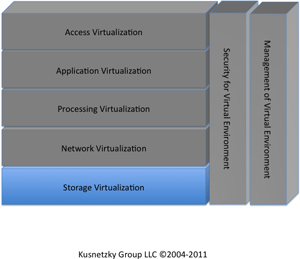Dan's Take
Storage Virtualization in the Cloud: A No-Brainer
Dan's excited about where the storage industry is headed.
- By Dan Kusnetzky
- 12/12/2014
Over the last month or so, I've spoken with multiple suppliers of various types of storage virtualization technology. Sometimes these suppliers use the term "storage virtualization"; other times, they wave the "software-defined storage" banner. Regardless of the catchphrase being used, this technology is extremely important to both virtualized environments and cloud computing services.
What is Storage Virtualization?
My book, "Virtualization: A Manager's Guide" (O'Reilly, 2011), offers the following definition for storage virtualization:
Storage virtualization creates an artificial view of the storage that hides the physical infrastructure from clients and servers. It provides the following functions:
Allowing distributed file systems
Remote storage devices are made to look like they were directly attached to the system. The local system does not know where they are located or what type of storage device they are.
Creating artificial storage volumes
Multiple storage devices can be harnessed together to create the image of a single, much larger storage device.
Creating arrays of storage volumes
Applications and data can be spread over a number of storage devices and storage servers to improve overall storage performance. This function can also be used to improve storage reliability. The same data can be stored on several storage devices or storage servers. If one storage device or server fails, the data can be reconstructed.
Allowing greater control of storage space
Storage devices can be segmented into several "file systems," allowing the storage device to be more fully utilized.
See Figure 1 for an illustration of where storage virtualization fits in the Kusnetzky Group model. It's easy to see how this would make storage as agile as virtual servers. Storage could be on-premises or off-premises, and if issues of latency and throughput are handled correctly, applications would never know, or care, where data resides.
 [Click on image for larger view.]
Figure 1. The Kusnetzky Group model of virtualization, and where storage virtualization fits.
[Click on image for larger view.]
Figure 1. The Kusnetzky Group model of virtualization, and where storage virtualization fits.
What's in Store(age)?
Although I'm not in a position to discuss what vendors are planning to announce over the coming weeks, I can point out that a great deal of attention is focused on making storage easier to install, provision and manage. Some suppliers are focused on making the use of storage as simple as dragging an icon from one place and dropping it somewhere else.
Other suppliers have developed exciting technology that can sit between traditional disks, flash storage, and their projection of future storage devices and the OS and applications. This makes it possible for enterprises to continue using today's storage devices and storage area networks and gradually bring in new technology, all without requiring a change to applications or OS parameters.
One supplier is in the process of extending this concept to make the storage system include Big Data databases, file systems and analytics software. The goal is making these tools easy to use for everyone -- small organizations all the way up to huge enterprises. I've seen an amazing demonstration in which an administrator can set up a compute cluster, add the necessary database and analytics software, and provision necessary storage simply by checking boxes and selecting functions from a slick graphical dashboard.
Dan's Take: Ignore Storage Virtualization at Your Own Risk
Storage virtualization is a must in both virtual and cloud computing environments. This technology does a number of useful things, including making it possible for applications to access needed storage without having to know where it's housed or what type of storage device is being used. It also makes it possible for stored objects to be moved from place to place or from one type of storage device to another, to manage the balance between cost and performance. It also makes it possible for multiple tenants to share the same physical storage devices without ever knowing that others are using the same device.
If organizations hope to make the best use of virtualized or cloud computing environments, the control of the data and the data itself must be separated. Enterprises don't want to deal with storage area networks, different types of storage devices and how they relate to the applications using storage. It doesn't matter to me if the vendor chooses to call this storage virtualization or software-defined storage. What matters is that enterprises take immediate steps to learn about this technology and put it to work.
About the Author
Daniel Kusnetzky, a reformed software engineer and product manager, founded Kusnetzky Group LLC in 2006. He's literally written the book on virtualization and often comments on cloud computing, mobility and systems software. He has been a business unit manager at a hardware company and head of corporate marketing and strategy at a software company.